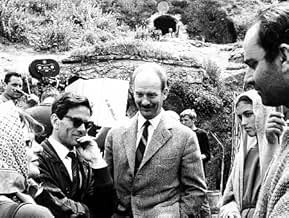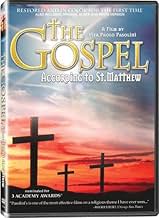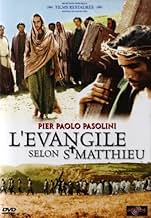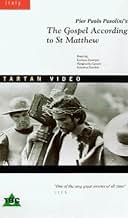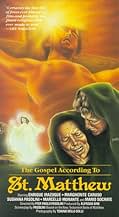ÉVALUATION IMDb
7,6/10
14 k
MA NOTE
La vie de Jésus-Christ selon les écrits de l'Évangile selon Saint-Mathieu.La vie de Jésus-Christ selon les écrits de l'Évangile selon Saint-Mathieu.La vie de Jésus-Christ selon les écrits de l'Évangile selon Saint-Mathieu.
- Nommé pour 3 oscars
- 7 victoires et 9 nominations au total
Juan Rodolfo Wilcock
- Caifa
- (as Rodolfo Wilcock)
Histoire
Le saviez-vous
- AnecdotesIn keeping with his idea of Jesus Christ as the greatest revolutionary of all time, Pier Paolo Pasolini considered casting Jack Kerouac or Allen Ginsberg in the role. He changed his mind when he met Enrique Irazoqui, a Spanish student of literature, who has written a thesis about Pasolini's novel "Ragazzi di vita" and was very curious to meet him.
- GaffesWhen they are taking Christ down from the cross, in the distance you can see a car driving around a corner.
- Citations
[last lines]
Christ: All authority has been given to me in heaven and earth. Go, therefore. And make disciples of all nations, baptizing them in the name of the Father, and of the Son and the Holy Ghost, teaching them to observe everything I have commanded you. And behold. I am with you always even unto the end of the world.
- Autres versionsThe 2007 DVD release features a colorized, English-dubbed version with a run time of 91 minutes and an Italian-language black and white version running 136 minutes.
- ConnexionsEdited into Histoire(s) du cinéma: Une histoire seule (1989)
- Bandes originalesMatthäus Passion (BWV 244)
Written by Johann Sebastian Bach
nr 78: Wir setzen uns mit Tränen nieder
nr 47: Erbarme Dich (musical intro)
Commentaire en vedette
Three ingredients make this movie truly remarkable and honest:
First - it contains perhaps the most powerful piece of MUSIC I ever experienced in a movie. I've never forgotten my utmost impression from that music when I saw the movie for the first time in a film-club some twenty-five years ago. From a total silence of the first titles, a music like an avalanche of a heavenly army hitting the soul ...
Which music it was? MISA LUBA! An incredible polyrithmic blend of three ingredients: a high melodic church chorus of Kenyan women, plus an unbelievably improvising african singer, plus a bunch of African drummers... everything locked together by an unrepeatable moment of inspiration and chance. I could not imagine some most powerful music to underline the most exposed passages of Jesus' story. Curiously and sadly enough, this MISA LUBA is even not credited in the movie titles, in contrast to a fair (but much more standard) classic music used in most of the movie. It was just this happy usage of MISA LUBA which contributes most to the soul and mood of the Pasolini film. It is also well understandable why Pasolini used an eclectic mixture of music from various continents, -- in an obvious intention to make the universal story yet more UNIVERSAL, across the nations and cultures.
Second happy aspect of Pasolini's interpretation is his cast of characters, his choice of believable and interesting types ... for Jesus, for Maria, and most other characters. These are believable and convincing types of people from the middle-east. How superior and fair is here Pasolini in comparison with all those funny blue-eyed and polished Hollywood casts of those pseudo-biblic stories ...
And third - Pasolini did very well to make the movie in black-and-white. It contributes to a mystical, spiritual and abstract atmosphere of the opus. In my opinion, it would be hardly possible to make this movie well in color.
And yes, I agree with those who say that practically all other movies about Jesus and those biblic stories are fundamentally wrong, and in cases of those (in)famous Hollywood versions - even funny to tears.
This Pasolini's opus is very honest and might be the 'very best film interpretation of Jesus' story.
First - it contains perhaps the most powerful piece of MUSIC I ever experienced in a movie. I've never forgotten my utmost impression from that music when I saw the movie for the first time in a film-club some twenty-five years ago. From a total silence of the first titles, a music like an avalanche of a heavenly army hitting the soul ...
Which music it was? MISA LUBA! An incredible polyrithmic blend of three ingredients: a high melodic church chorus of Kenyan women, plus an unbelievably improvising african singer, plus a bunch of African drummers... everything locked together by an unrepeatable moment of inspiration and chance. I could not imagine some most powerful music to underline the most exposed passages of Jesus' story. Curiously and sadly enough, this MISA LUBA is even not credited in the movie titles, in contrast to a fair (but much more standard) classic music used in most of the movie. It was just this happy usage of MISA LUBA which contributes most to the soul and mood of the Pasolini film. It is also well understandable why Pasolini used an eclectic mixture of music from various continents, -- in an obvious intention to make the universal story yet more UNIVERSAL, across the nations and cultures.
Second happy aspect of Pasolini's interpretation is his cast of characters, his choice of believable and interesting types ... for Jesus, for Maria, and most other characters. These are believable and convincing types of people from the middle-east. How superior and fair is here Pasolini in comparison with all those funny blue-eyed and polished Hollywood casts of those pseudo-biblic stories ...
And third - Pasolini did very well to make the movie in black-and-white. It contributes to a mystical, spiritual and abstract atmosphere of the opus. In my opinion, it would be hardly possible to make this movie well in color.
And yes, I agree with those who say that practically all other movies about Jesus and those biblic stories are fundamentally wrong, and in cases of those (in)famous Hollywood versions - even funny to tears.
This Pasolini's opus is very honest and might be the 'very best film interpretation of Jesus' story.
- gott-1
- 2 mai 2002
- Lien permanent
Meilleurs choix
Connectez-vous pour évaluer et surveiller les recommandations personnalisées
- How long is The Gospel According to St. Matthew?Propulsé par Alexa
Détails
- Date de sortie
- Pays d’origine
- Langue
- Aussi connu sous le nom de
- The Gospel According to St. Matthew
- Lieux de tournage
- Castel Lagopesole, Avigliano, Basilicata, Italie(Sanhedrin trial of Jesus, in castle's courtyard)
- sociétés de production
- Consultez plus de crédits d'entreprise sur IMDbPro
Box-office
- Brut – à l'échelle mondiale
- 16 572 $ US
- Durée2 heures 17 minutes
- Couleur
- Mixage
- Rapport de forme
- 1.85 : 1
Contribuer à cette page
Suggérer une modification ou ajouter du contenu manquant

Lacune principale
By what name was Il vangelo secondo Matteo (1964) officially released in India in English?
Répondre

